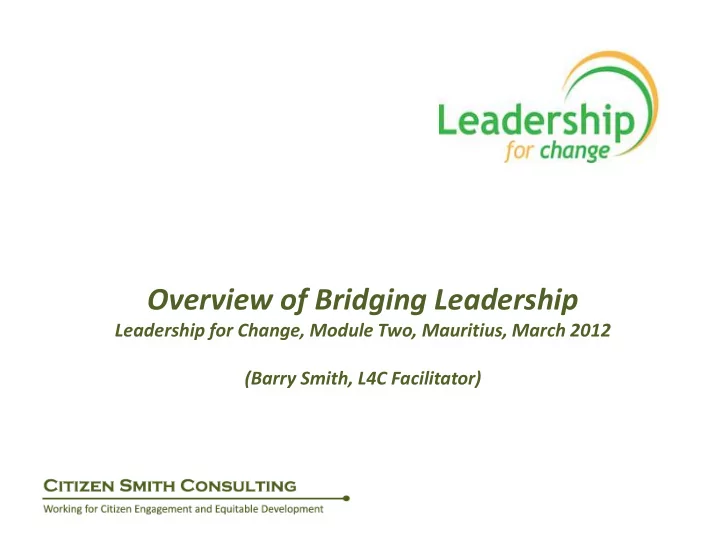

Overview of Bridging Leadership Leadership for Change, Module Two, Mauritius, March 2012 (Barry Smith, L4C Facilitator)
Bridging Leadership Bridging Leadership is a leadership style or approach to tackle complex and systemic social inequities: That are beyond the capacity of one sector alone to resolve. That need collaborative action of all sectors – government, private sector and civil society. Around which resolve to redress social inequities must be nurtured and shared by the multiple stakeholders. Around which bridging leaders can convene diverse stakeholders to own the issue and its resolution.
Bridging leadership A paradigm shift in thinking about leadership: FROM Leaders as TO Leaders as Commander and controller Facilitator and convener Sole owner of the problem and solution Prime mover, but a co-owner of the problem and solution Having all the answers Creator of the conditions where answers emerge A single intelligence Focuser of collective attention and the distiller of collective intelligence Head of one organization Ligament between organizations and institutions across a system Holder of power Distributor of power, letting go to enable new things to emerge Expert Non-expert, mobilizing the expertise of others
Bridging leader action framework Ownership Co-Ownership Co-Creation • The Bridging Leader makes a • The Bridging Leader convenes • A social innovation/intervention is personal response to the issue stakeholders to co-own the issue adopted and carried out through new institutional arrangements/partnerships. • Understands its systemic analysis • Through a process of dialogue and and recognizes the interests of engagement, the stakeholders arrive at • Over time, the arrangements are its many stakeholders a shared vision and shared response. institutionalized into formal structures and processes together with a policy environment supportive to stakeholders’ • The vision becomes the societal participation and responsive institutions. outcome aspired for by everyone. • The Bridging Leader sustains her/his work by cultivating sources of renewal. Source: Asian Institute of Management
What do bridging leaders need to BE? Recognition of one’s character and values and how Self-Aware of strength and inspiration can be drawn from these Character in facing the challenges and uncertainty that come and Values with complexity Clarity of what should be done and how it can be Strong Sense done in order to be purposive and strategic in of Purpose addressing complex inequities Willingness to work with others, in a way that taps Capacity to their greatest potential, toward collaboratively Transform finding and implementing solutions to the inequities E Garilao
What do bridging leaders need to KNOW? A new perspective, a specialized language, and a set of tools that can be used to understand reality Systems as a whole – the relationships among the parts of a Thinking system – rather than the parts themselves Setting up and facilitating dialogic processes that Multi- bring together diverse stakeholders into Stakeholder constructive engagement, dialogue and collective Processes decision making ‘Emergent processes’ i.e. tools and capacities to discuss how one can sense the future as it Creativity emerges or sense it from the pieces of the future held by other stakeholders E Garilao
What do bridging leaders need to DO? Articulation of the leader’s set of values and Strengthen capital as well as the leader’s understanding of the will to lead inequities being faced as input for verbalizing and through self- concretizing the personal response that the leader awareness commits to Convene a multi- Engaging diverse stakeholders and building trust stakeholder among them toward reaching a shared vision on group that is how to address the current reality of inequities built on trust Leading the collaborative implementation of Change innovative programs that will result to societal institutional equity and that are based on new institutional arrangements arrangements that make institutions responsive and empower citizens E Garilao
A bridging leader: Has a formal/ informal mandate & accountability to address a social cause Has necessary authority/ leadership to take independent decisions and partner with other stakeholders Has clearly articulated/ displayed passion to address the social cause Can influence the system and implement the desired interventions- upwards, side-wards and downwards, with or without formal authority Displays ‘ participatory consciousness ’ as against ‘top - down’, ‘expert’ or ‘interventionist approach’ - i.e. believes in the fact that complex social issues cannot be addressed by just one best solution but by collaboration, participation and ownership of community & other stakeholders Key questions asked of the bridging leader: What is my relationship capital? What is the social return on my relationship capital? What assets and competencies do I bring to the process?
Recommend
More recommend